|

 Up
Up 
 Pilots,
Pilots,
Planes
and Pioneers

(You are here.)
 Down
Down




  Need
to Need
to
find your
bearings?
Try
these
navigation aids:
If
this is your first
visit, please stop by:
Something
to share?
Please:



|
|
Available in Française, Español, Português, Deutsch, Россию,
中文,
日本, and others.
 hile
the Wright brothers may have been the first to make a sustained,
controlled flight, they were just two among hundreds of brave men
and women who helped to give the world its wings during the earliest
days of aviation. Their Flyer was but one of many historically
important aircraft. Below are brief descriptions and photos of some
of the most important people and planes, and where available
resources and links where you can find more information. In some
cases, contributors have supplied expanded
histories and biographies. Those are listed at the right and linked below. hile
the Wright brothers may have been the first to make a sustained,
controlled flight, they were just two among hundreds of brave men
and women who helped to give the world its wings during the earliest
days of aviation. Their Flyer was but one of many historically
important aircraft. Below are brief descriptions and photos of some
of the most important people and planes, and where available
resources and links where you can find more information. In some
cases, contributors have supplied expanded
histories and biographies. Those are listed at the right and linked below.
A
 B
B
 C
C
 D
D
 E
E
 F
F
 G
G
 H
H
 I
I
 J
J
 K
K
 L
L
 M
M
N
 O
O
 P
P
 Q
Q
 R
R
 S
S
 T
T
 U
U
 V
V
 W
W
 X
X
 Y
Y
 Z
Z
|
|
 |
|
Sir Charles Parsons,
an Irish inventor and the son of a renowned astronomer, developed
the first compound turbine steam engine in 1884 and went on to build
both axial and radial turbines, the predecessors of the jet engine.
Parsons' turbine was originally designed to generate electricity,
but in the 1890s he adapted it to propel ships. He built a sleek
104-foot (32-meter) yacht he christened the Turbinia with
three radial turbines driving nine propellers. The ship could make
35 knots (65 kilometers per hour), 20% faster than anything else in
the water at the time. In 1893, he developed a lightweight steam
engine and used it to propel a successful model airplane and a
semi-successful model helicopter. Some historians have identified
the Parsons model as the first jet aircraft, but this is incorrect.
While Parsons' work on turbines did eventually lead to the jet
aircraft engine, the small 1/4 horsepower engine in Parsons' models
was a standard reciprocating steam engine with a single piston. He
also made significant contributions to other technologies,
including marine propellers, gear-cutting, outdoor lighting,
parabolic mirrors, optical glass, and astronomical telescopes.
|
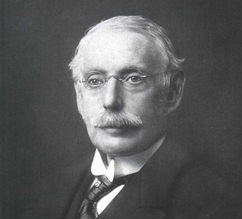
Sir Charles Algernon Parsons was knighted in 1911.
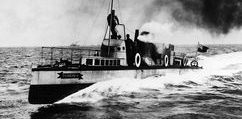
In 1897 Parsons crashed a review of the assembled British fleet with his
speedboat/yacht Turbina,
darting up and down the lines of military ships so fast that none
could catch him. The bold demonstration caught the attention of
the British brass and two years later he was making turbines for the
Royal Navy.
|
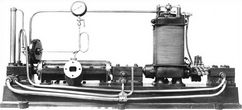
Parsons' first steam turbine (left), built in 1884, ran a small
electric generator (right) producing 7.5 kilowatts. By 1899, he was
producing turbine-powered megawatt generators for power plants.
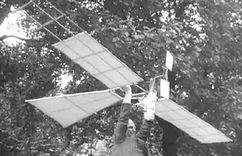
A reconstruction of Parsons' 1893 steam-powered monoplane and a
blurry photo of the real thing in flight. The airplane could achieve
an altitude of up to 20 feet (6 meters) and test-flights covered up
to 300 feet (91 meters).
|
 |
|
Alphonse
Penaud of France was born to a family with a naval tradition, but
a crippling hip disease prevented him from pursuing a career in the French
Navy. Instead, he devoted his short life to aeronautics. In 1870, he
invented the "torsion motor" -- the twisted rubber bands that
have been used to power model airplanes ever since. That same year he
developed a rubber band-powered helicopter with contra-rotating
propellers. In 1871, he built a "planaphore," a rubber
band-powered airplane. It was the first airplane in history to have both
longitudinal and lateral stability. Penaud achieved longitudinal stability
by setting the horizontal tail at an 8-degree negative angle to the
wings, and lateral stability by setting the wings at a dihedral
angle – the wings sloped upwards slightly from the root to the wing tips. This
model astounded the French Societe de Navigation Aerienne on April 18,
1871 by flying 131 feet in 11 seconds. In 1874, Penaud developed a flying
ornithopter model, again powered by rubber bands. In 1876, he designed and
patented – but never built – a full-size aircraft of surprising
sophistication. It was an amphibian incorporating twin
contra-rotating propellers, retractable landing gear, a glass-enclosed
cockpit, a single column to work both the rudder and elevator, and movable
trailing edges on the wings. Discouraged by his failing health and
inability to secure funding to build his airplane, Penaud killed himself
in 1880 at the age of 30. |
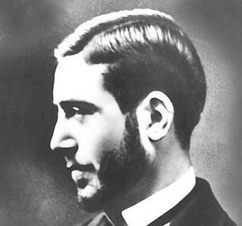
Alphonse Penaud.
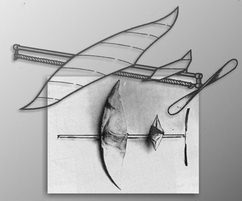
A drawing of Penaud's 1871 "planaphore" superimposed on a photo of a
vintage planaphore. Penaud and many other manufactures reproduced
his designs for rubber-band powered airplanes, helicopters, and
ornithopters and sold them as children's toys.
|
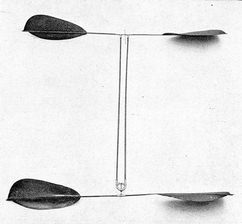
Penaud's 1870 helicopter, sans its rubber band. As the wound band
released its energy, the top and bottom blades turned in opposite
directions. The blades were pitched to generate thrust in just one
direction and the gyroscopic forces they generated kept the
helicopter on a straight course.
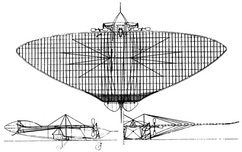
Penaud's 1876 design for an amphibian aircraft of surprising modern
design. Just before he committed suicide, Penaud made a small
coffin, put his plans in it, and had it sent to patron who he was
trying to convince to fund the project.
|
 |
|
Horatio
F. Phillips of England built a wind tunnel in which he experimented
with wings of "every conceivable form and combination of forms."
In 1884, he published a series of "aerocurves" – cambered wing
shapes. Building upon
Browning's and
Wenham's
earlier wind tunnel work, Phillips showed experimentally that
different shapes produce different amounts of lift. In 1891, he patented the first double-surfaced airfoils -- wing
shapes with a greater curve on the top than on the bottom. He also proved that when the wind blows across a curved surface, it
creates a low pressure area on top of the surface and high pressure
beneath it. This, in turn, generates lift. This work established the scientific foundation for modern airfoil design.
In 1893, 1904, and 1907 he tested several unique "Venetian
blind" aircraft with multiple high aspect (narrow chord, long
wingspan) wings. The first of these were flown tethered on a circular
track and showed promising lifting ability. But when later models were
flown in free flight, the best Phillips could manage was a hop flight of
about 500 feet (152 meters). |
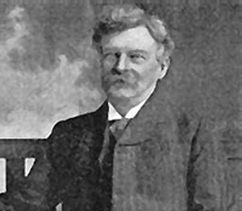
Horatio Fredrick Phillips.
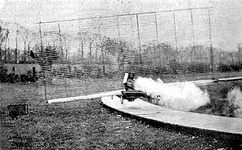
Phillips' 1893 test rig consisted of a captive aircraft and a
circular track. The aircraft was tethered to a pole in the middle of
the track.
|
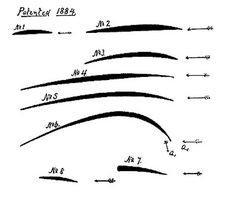
Phillips tested these wing shapes – "aerocurves, he called
them – and patented those he thought would produce sufficient lift
to support an airplane.
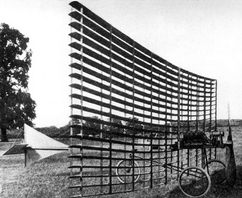
Phillips' 1904 aircraft was meant to fly free. Although it managed a
few hops, it could not sustain itself in the air.
|
 |
|
Percy Pilcher of
Scotland spent six years in the Royal Navy, then mustered out to become an
engineer. In 1893, he was a professor of marine engineering at the
University of Glasgow, he worked for Hiram Maxim in 1896, and in 1897 he
became a member of the Aeronautical Society. He built his first glider, the
Bat, in 1895. Before he could test it, he visited
Otto Lilienthal
in Germany and asked for
advice. Lilienthal pointed out the necessity of a tail, but Pilcher refused
to take him seriously. When he returned to Scotland and tried to fly the Bat,
he discovered Lilienthal was right. His next glider, the Beetle, had
a tail. But it was heavily built and hard to handle in the air; Pilcher
had no more success with it than he had with the Bat. Late in 1895 Pilcher built a third glider, the Gull, with a huge wing surface of
300 square feet (28 square meters). Because of its size, it was only safe to fly on calm days. After
damaging the aircraft several times in stiff breezes, Pilcher abandoned
it. Pilcher's fourth machine, the Hawk, was a winner. He first flew
it in the summer of 1896 with good results and later adapted it to be
towed into the air with a simple rope and pulley. Using this launching
system, he made a record glide of 750 feet (229 meters) in 1897. His
experiments attracted much attention and many who watched were happy
to help. Once forty men pitched in to tow him aloft. After the
flight, Pilcher wryly commented that "twenty would have been
sufficient." During the same year,
he began to formulate plans for a powered aircraft. During 1898, he built
an engine for his powered aircraft and bench-tested it in 1899. He also
met Lawrence Hargrave in 1899 and was intrigued by his box kite designs.
He adapted his plans for a powered flying machine and built a triplane
incorporating many of Hargrave's ideas. However, he never got to test it;
he was killed while demonstrating the Hawk on September 30, 1899. |
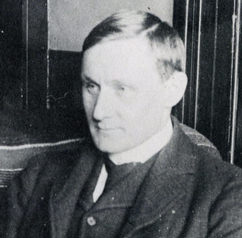
Percy Sinclair Pilcher.
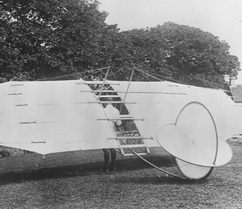
Pilcher hung beneath the 1895
Beetle rather than flying with his head and shoulders above
the wing. This gave the aircraft a lower center of gravity and made
it less responsive to weight-shifting as a means of control.
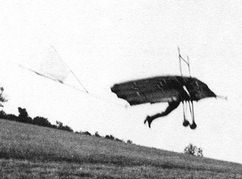
Pilcher's most successful glider, the 1896
Hawk, was able to keep him
aloft for up to a minute.
|
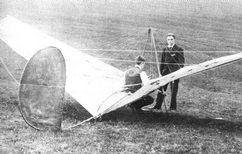
Pilcher's 1895 Bat with a
vertical tail added. The excessive dihedral angle of the wings was
intended to improve stability, but in fact it reduced lift.
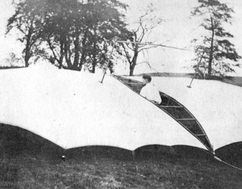
The 1895 Pilcher Gull had
the largest wing area of any glider to fly and held that record
until the Wrights flew their 1901 glider.
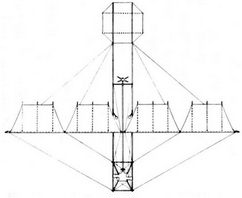
A 3-view of the powered triplane that Pilcher built but never
tested. It had a two-cylinder engine weighing just 40 pounds (18
kilograms).
|
 |
|
|
|

